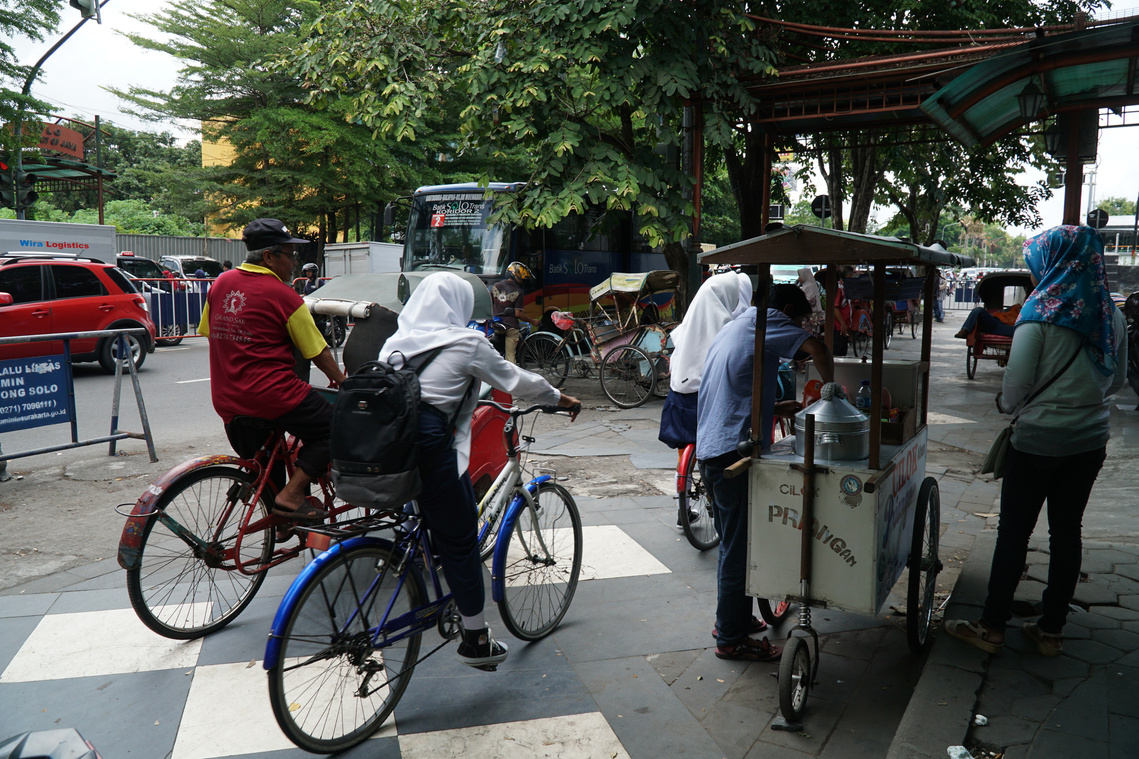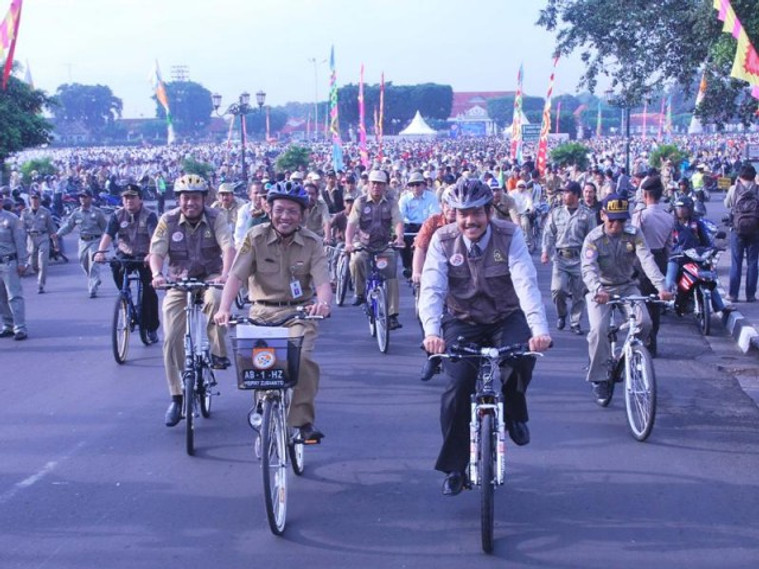Yogyakarta and Solo
December 2-6
Cities in Context
As seen in the case of Jakarta, Indonesian cities today are becoming more prosperous, with demand for mobility amongst the urban poor rapidly growing. One does not have to look far beyond to Jakarta to realize that medium-sized Indonesian cities like Yogyakarta (referred to by the locals as “Jogja”) and Solo in Central Java are also experiencing growth, and, if not acted upon soon, can lead to streets frozen with congestion and poor public transportation supply like Jakarta. So what is so special about these two cities?
Jogja and Solo are mid-sized cities with populations of 422,000 and 514,171, respectively. Jogja and Solo are small, compact cities with a different kind of urban form than megacity Jakarta; The cities feature high population density, lower populations, fewer vehicles on the roads, and different sorts of goods moving through their economies. These characteristics make for a completely different set of mobility needs.
Jogja and Solo differ in terms of urban development patterns. Jogja has a hub-and-spokes pattern, with all important functions such as markets and government institutions centrally located. Major arterial roads radiate from the center and connect to a ring-road around the city boundary where many universities are located. This results in more people moving from neighborhoods and the periphery to the center.
Solo has a polycentric pattern,with important centers including historic monuments, employments centers, and new shopping malls evenly distributed throughout the city. Trip movements are more concentrated within specific districts where people both live and work.
Both cities are served by informal public transportation systems. The past years have seen the implementation and integration of formalized bus systems as well. By visiting Yogyakarta and Solo, I sought to find out what unique strategies are being taken by NGOs and city officials to provide mobility that suits the needs of residents across gender and income levels. This would help me better understand the mobilities of medium sized Indonesian cities.
Formal vs. Informal Public Transport - What answers lie in Integration?
Cities in the developing world are grappling with the introduction of public transport services and the restriction of informal transport. I have seen this in cities larger cities like Nairobi and Cape Town during my travels. On one hand, formalized routes provide structure and can more adequately service corridors with high transport demand. Accentuating the need for organization is the fast pace of economic growth, leading to more cars, motorbikes and worsening traffic. On the other hand, informal transport providers go everywhere in cities, with their flexibility making them so useful especially in poorer areas of the city.
In Solo, the formalized Batik Solo Trans (BTS) was launched on 1 September 2010 by then-mayor of Surakarta Joko Widodo (today, he is the President of Indonesia!). The service, which initially had only a single corridor and 38 stations, was expanded with its second corridor in 2014 and a third in 2018. It was developed as part of a 2007 initiative by the national-level Ministry of Transportation. Low ridership led to Solo's new bus lines having little to no influence on air quality, economic activity, or accessibility. Planners immediately blamed the widely available informal transit modes.
Three main types of informal transport ply the streets of Jogja and Solo. Angkots transport commuters and goods to and from markets and students to school. Becaks are non-motorized three-wheeled bikes that are used as a taxi (above, left). Ojeks, perhaps one of the most popular forms of informal transport, are motorcycles that are used to carry a passenger on the back (above, right). Allowing informal transport to carry on without regulation is seen as a detriment to the success of new formalized transport systems by some government officials in Jogja and Solo. Extensive discussion and engagement with informal service providers is necessary to find solutions that work for all of society.
In 2015, local NGO Kota Kita conducted a study calling for the integration of the newly formalized BST bus system with the informal angkots in Solo. Kota Kita was able to collect relevant data that filled knowledge gaps about angkot riders and routes, along with the needs, motivation, and aspirations of angkot drivers. For example, it was shown that angkot routes were superior in terms of servicing the distributions of the urban poor, age groups, and the city’s community and educational facilities. The report argues for open and constructive engagements with a clear vision of seeking mutual benefits. Beyond simply advocating for technical engineering solutions, Kota Kita seeks to build social capital by bringing together stakeholder organizations and the government. Thanks to these efforts, Solo's BST uses angkots to act as feeders to the service beginning in 2017.
To read Kota Kita's report on Batik Solo Transit and Angkot Integration, click here.
To read more about Informal Public Transportation Networks in Jogja and Solo, click here.
Women on Wheels - Promoting Cycling for Women in Indonesia
Bicycling is not a new trend in Indonesia, having been one of the remnants from the Dutch colonial era. The bicycle has been popular for generations, but has become neglected as a mode of transport over the last twenty years. Economic growth, low cost access to finance, aggressive marketing, low parking costs and motorcycle’s capacity to go anywhere on the cheap has led to many families switching to the motorcycle. At the same time, increased traffic and poor road maintenance has led to reduced comfort and mobility of cyclists.
Yogyakarta and Solo are cities that buck the trend of lacking bicycle infrastructure. Jogja took the initiative between 2008 and 2011 during the mayoral term of Herry Zudianto, when his “Segosegawe” Campaign (Bike to Work and School) created bicycle “slow lanes” (bike lanes) and parking. The Mayor also promoted the use of bicycles for students by giving them away as incentives for high performing students. The initiative also required government officials to use bicycles to ride to work every Friday morning, including the Mayor! The campaign increased bicycle use in Jogyakarta and made the city bicycle-friendly. The increase was observed not just for recreational uses, but also as a transportation mode. However, the success was short-lived after Mayor Zudianto lost power to current Mayor Suyuti, who refuses to support pro-cycling policies.
Former Mayor Herry Zudianto of Yogyakarta leading the "Segosegawe" Campaign.
Image source: Sidomi
Solo is another good example. It is well suited for bicycle use because it is dense and flat, as evidenced by the popularity of becaks. The city is also home to the largest slow lane in Indonesia and a sizeable population of users, mainly female factory workers who work in the batik textile and plastic trades. Events like Car Free Sunday and Solo Last Friday Ride spread awareness of the bicycle as a mode of transport. However, the recent proliferation of motorcycles has crowded out parking spaces for bicycles. The slow lane, typically reserved for non-motorized transport is often blocked by parked cars and street vendors.
Women are disproportionately affected by this reduction in comfort for cycling. Many working-class women belong to families which have only one motorcycle, and in cases where the spouse is using the motorcycle, women are the least privileged to use the motorcycle for mobility. This leaves the bike as the next most attractive option. In this vein, Kota Kita developed a pilot to promote cycling for women in Solo in 2018. Together with researchers, the Solo city government, bicycle groups, and citizens, the Women on Wheels pilot introduced a series of public campaigns and bike clinics to improve cyclists’ capacity and readiness on the road, an integrated bicycle map for tourism, leisure, and safe routes information, and advocacy for inclusion of pro-cycling agenda and initiatives into city budget.
Before Women on Wheels, there was little coordinated effort to promote bicycling for women in cities. The campaign is the first time a sustained effort is promoting cycling for civil society and local governments simultaneously. In this manner, Kota Kita seeks to take an integrated approach to account for road safety considerations, bicycle infrastructure, incentives for companies to get involved, social promotional campaigns and enforcement of regulations.
I am thankful to have spoken with Titis Efrindu Bawono, an urban mobility specialist in the Women on Wheels project. As an avid cyclist, Titis and I bonded over our shared love of cycling. Check out his website, Transportologi, which seeks to spread awareness of sustainable transportation in Indonesia through engagement with local youth and stakeholders. Also check out this article he co-wrote, advocating for more bicycle infrastructure in Indonesian cities.
Parting Thoughts
I managed to see the magnificent Borobudur temple (see below), the largest Buddhist temple in the world and UNESCO World Heritage Site. I rented a two wheeler to make the 45 minute trek to the site. Along the way, while turning into a gas station, I fell off of my motorbike. I thankfully escaped with only a bloody knee, hand and damaged pride. The trip was well worth it, and was justified by conducting experiential research of what mobility via two-wheeler is like in Yogyakarta. It served as a stark reminder of the dangers one faces while riding a motorcycle.
After seeing the chaos in Jakarta, I found my time in Yogyakarta and Solo to be extremely eye-opening and peaceful. These medium-sized cities may have different transport challenges than Jakarta, but they offer a number of important lessons in the realm of informal transport integration and promotion of active mobility modes.




































